QuestionHello..I have a 10 week old miniature female poodle, who came home to us 3 weeks ago. Generally she has a wonderful and loving nature, however I've also noticed a aggressive trait in her personality that I certainly never experienced with my previous poodle. When playing she displays the normal biting behaviour which I supervise so she doesn't become over excited. However at times she seems to lose total control and becomes a 'ball of black fury' defensively growling, snapping and snarling. I respond by playing the 'den mother' by pinning her down to a submissive position,firmly saying "No" then release and walk away from her and she seems to be responding - but there is still an 'undercurrent' of unpredictability. For example once when she was calm I attempted to get her used to grooming by gently brushing her with a wide tooth brush where she literally went 'psycho' and snapped and snarled at me. She is certainly intelligent and already sits on command, retrieves, waits for her food etc and is very sociable. I met her parents who were well behaved, however the breeder did mention the father was jealous of the puppies and would often have a go at them when not supervised. I'm not sure if this experience has contributed to her displaying defensive aggressive behaviour.
Also..TOILET TRAINING!! I consistently walk her to the front door to go outside to do her toilet (where I have a toilet post). This takes place immediately after eating, playing or sleeping and I lavish lots of praise upon her when she performs outside, but after three weeks she still will not go to the door of her own accord and as a result my rug suffers (on the odd occasion). At night she sleeps in a confined area and if needs will do her toilet on newspaper but doesn't attempt to use the newspaper during the day. We are besotted with our little girl 'Jezebel' and would very much appreciate any suggestions. Many thanks.
AnswerIt certainly sounds like she isn't accepting your leadership. The ''den mother'' technique can be very effective although most people are moving to more positive methods now. The key to most behavior problems is approaching things using the dog's natural instincts. Dogs see all the people and dogs in the household as a pack with each having their own rank in the pack and a top dog. Life is much easier if the 2 legged pack members outrank the 4 legged ones. You can learn to play the role of top dog by reading some books or going to a good obedience class. A good obedience class or book is about you being top dog, not about rewarding standard commands with a treat. Start at http://www.dogsbestfriend.com/ There are some variations on rolling the dog over that are not done as punishment that work well.
''Elevation for small puppies: Sit on the floor and gently put your hands around your pup's middle, below his front legs, and lift him up. He is facing you. Hold him for 15 seconds. Repeat until he no longer struggles. If he is past 10-12 weeks, lift his front feet off the ground, but don't pick him up.
Cradling for small puppies: Hold your puppy gently on his back, as you would cradle a small baby. If he struggles, hold him firmly until he quiets for 10-15 seconds. With larger pups, you can do this as your sit on the floor, with your pup between your legs.
Quiet lying down: Place your pup on the floor on his side, with all 4 legs pointing away from you. Use your hands on his neck/shoulder area and middle, to hold him in this position. When he is quiet, praise him. Lengthen the time that you keep him quietly in this position. When he accepts this position well, handle his paws and muzzle, while keeping him quiet.''
The quotes mean this isn't my original work. It is copied from my Puppy Raising Manual. I have long used these or minor variations of them, and they are very effective. You may want to give him a belly rub while he is on his back too. Helps bonding. There is a big difference between him rolling over and demanding a belly rub, and you choosing a time to roll him over and rub his belly. The latter cements your place as pack leader.
Taking the dog out too often and not when you read the signs it needs to go out sometimes slows learning to go to the door. Read through this:
Much of housebreaking is not training the puppy, but making it easier for your
puppy, you, and your carpet while its body to catches up to its instincts. At
around 8 weeks when the puppy goes to its new home, the time from when it
realizes it has to go, and when it can't wait any longer is a matter of
seconds. Only time will fix that. You can hardly be expected to be attentive
enough to avoid all accidents. There is no sense punishing the puppy for your
inattention. It is not fair to punish you either, but you still have to clean
it up if you didn't have the puppy outside in time.
Housebreaking starts before you get home with the new puppy. If you don't have
a crate, buy one. I prefer the more enclosed, den like plastic ones. Skip the
bedding. At first it gets wet, and later it can be chewed into choking
hazards. A wire grid in the bottom will help keep the puppy up out of
accidents at first. They are available with the crates, but expensive and hard to find. A piece of closely spaced wire closet shelving from a home supply place is cheaper. I am now using a plastic vegetable bin with plenty of holes drilled in the bottom. It helps block off part of the crate for the smaller puppy. If you already have a metal crate, covering it may help. Just make sure you use something the puppy can't pull in and chew. Dogs that start out in crates as little puppies, accept them very well. Never leave an unattended puppy loose in the house. If nobody can watch it, put it in the crate. I suggest letting the dog have its crate all its life. A crate needs to be just big enough for a dog to stretch out in.
Choose a command and spot you want it to use. The less accessible to strays,
the less chance of serious disease. If it is a female, choosing a non grassy spot will avoid brown spots later. When you bring it home, take it to the spot and give it the command in a firm, but friendly voice. Keep repeating the command and let the puppy sniff around. If it does anything, praise it. Really let it know what a good dog it is and how much you love it, and maybe a treat. Note, being out there not only means you can praise it, but it also keeps it from being snatched by a hawk. If it doesn't go, take it inside and give it a drink and any meals scheduled. A young puppy will need to go out immediately afterward. Go to the spot and follow the above routine. Praising it if it goes is extremely important. If it doesn't go, take it back inside and put it in its crate and try again soon. Do not let it loose in the house until it does go.
At first it is your responsibility to know and take the puppy out when it
needs to go. It needs to go out the first thing in the morning, after eating,
drinking, and sleeping. If it quits playing, and starts running around
sniffing, it is looking for a place to go. Take it out quickly. You will just
have to be what I call puppy broke until it is a little older. How successful you are depends on how attentive you are.
By the time most dogs are about 3 months old, they have figured out that if
they go to the door and stand, you will let them out. The praise slowly shifts
to going to the door. Some people hang a bell there for the dog to paw. If
your dog doesn't figure this out, try praising it and putting it out if it
even gets near the door. When you catch it in the act, give it a sharp ''Ah, ah, ah!'' and take it out. Clean up accidents promptly. I mostly keep the little
puppies out of the carpeted rooms. Still I need the can of carpet foam
sometimes. First blot up all the urine you can with a dry towel. Keep moving
it and stepping on it until a fresh area stays dry. A couple big putty knives
work well on bowel movements. Just slide one under it while holding it with
the other. This gets it up with a minimum of pushing it down into the carpet.
This works with even relatively soft ones, vomit, dirt from over turned house
plants, or anything else from solids to thick liquids. Finish up with a good
shot of carpet foam. Note, do not let the puppy lick up the carpet foam.
Once the dog is reliably housebroken, your carpet may need a good steam cleaning.
Many people strongly strongly push cleaning up all evidence of past accidents. I am slower to suggest that. Dogs will return to the same spot if they can find it. When you see one sniffing the spot, that is your clue to run it out.

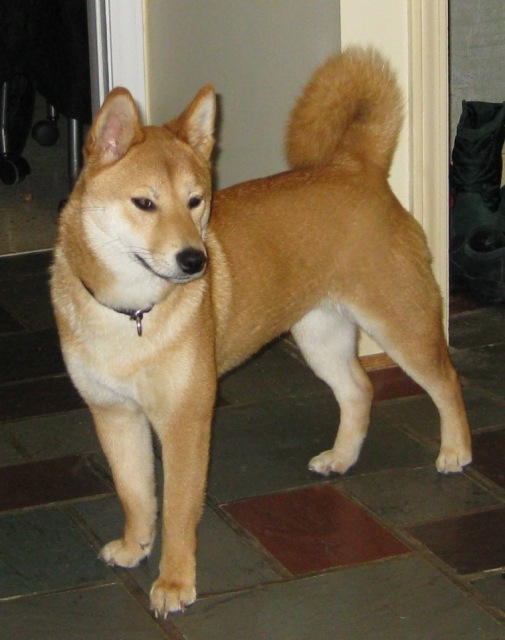 Rescued Shiba with ISSUES
Question
Shredder
Hi, I consider myself an experienced
Rescued Shiba with ISSUES
Question
Shredder
Hi, I consider myself an experienced
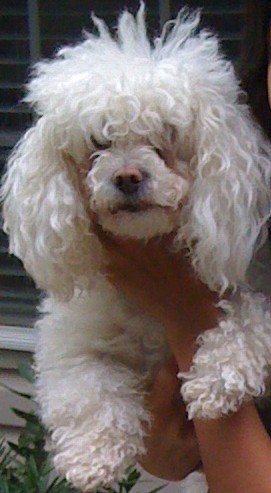 Poodle Depression??
Question
Buubles
Hi, I have a 7 year-old toy poodle. Sh
Poodle Depression??
Question
Buubles
Hi, I have a 7 year-old toy poodle. Sh
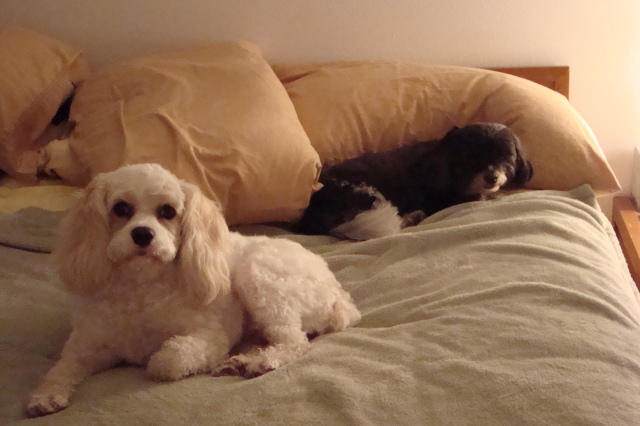 cavapoo
Questionshabby
QUESTION: Our cavapoo is 2 years
cavapoo
Questionshabby
QUESTION: Our cavapoo is 2 years
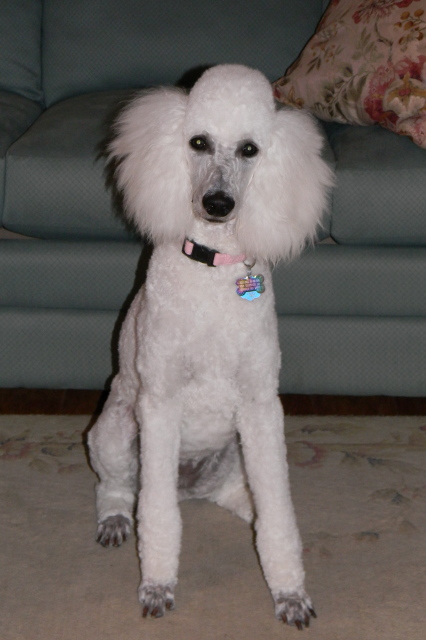 skittish about new things
Question
female standard poodl
We got our female stand
skittish about new things
Question
female standard poodl
We got our female stand
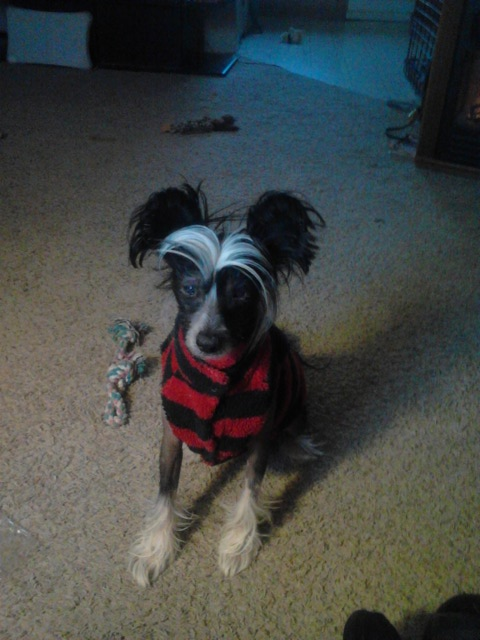 poodle just shaved
QuestionI have an almost one year old standard poodle m
poodle just shaved
QuestionI have an almost one year old standard poodle m